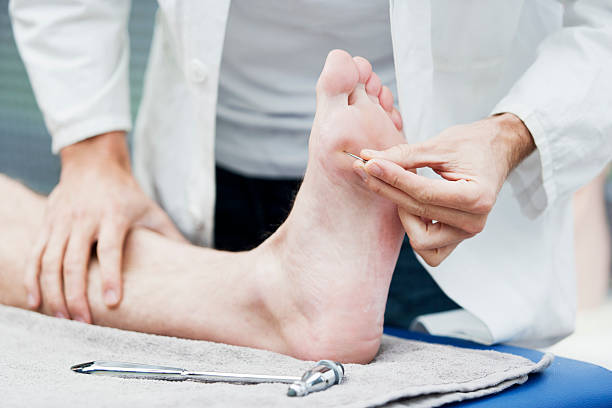
Best Doctor For Diabetic Foot Treatment in Thane

Book your appointment now with The Best Doctor For Diabetic Foot Treatment in Thane. most frequent foot injury that results in lower extremity amputation is diabetic ulcers. Family doctors are essential in preventing or identifying problems with diabetic feet early on. The management of diabetic foot necessitates careful preventative maintenance, periodic routine evaluations, and a comprehensive understanding of the key amputation risk factors. Peripheral artery occlusive disease, diabetic neuropathy, and anatomical foot deformities are the most prevalent risk factors for ulcer formation. A thorough physical examination can detect individuals who are at risk for developing foot ulcers and correctly classify those who already have ulcers or other diabetic foot issues. This examination is supported by noninvasive testing for arterial insufficiency and monofilament testing for neuropathy. Contact us now because we have Best Doctor For Diabetic Foot Treatment in Thane.
What are foot and toe ulcers?
An open sore or wound that won't go away or keeps coming back is called an ulcer. Diabetes, specifically a condition known as neuropathy that results in a loss of feeling in the feet, may be linked to ulcers on the feet and toes. If you have neuropathy, a cut, scrape, or puncture in your skin may become an ulcer, but you may not even be aware of it. Therefore get in touch with us because we have the Best Doctor For Diabetic Foot Treatment in Thane. Infections can result from ulcers. In certain cases, the infection may not clear up, in which case you may need to have a portion of your foot or toe amputated. An ulcer on the foot or toe will occur in about 15% of diabetics.
What causes foot and toe ulcers
Complications of Diabetic Foot Problems
An infected cut or wound can get worse. They are more common in those with immune system issues and injury to the nerves and blood vessels. Most infections occur in wounds that have already received antibiotic treatment. Antibiotics can be used to treat infections. Severe instances can need hospital care. Medicare Hospital has one of the Best Doctor For Diabetic Foot Treatment in Thane.
Occasionally, an abscess—a pocket of pus—is created when an infection eats away at bone or tissue. Draining the abscess is the typical course of treatment. Although some bone or tissue may need to be removed, more recent techniques like oxygen therapy involve less intrusive measures.
Diabetes has an impact on the blood arteries supplying your toes and fingers. Tissue can perish when blood flow is interrupted. Surgery to remove the afflicted region or oxygen therapy are the typical forms of treatment.
In addition to causing issues like hammertoes, claw feet, large metatarsal heads, and pes cavus, or a high arch that doesn't collapse under weight, nerve injury can weaken the muscles in your feet.
Diabetes can cause your foot's bones to deteriorate to the point of breaking. Damage to the nerves might diminish feeling and keep you from noticing it. Your foot will become reshaped if you continue to walk on fractured bones. Your arch may appear to have fallen into a rocker form.
People with diabetes are more prone to have a foot injury and not realise it until an infection develops because of issues with blood flow and nerves. An amputation is frequently the best course of action when an infection cannot be treated, forms an abscess, or insufficient blood supply results in gangrene. We have Best Doctor For Diabetic Foot Treatment in Thane.
Signs of Diabetic Foot Problems
Conclusion
Treatment for diabetic foot necessitates a comprehensive strategy that incorporates wound care, offloading methods, vascular assessment, and multidisciplinary care. People with diabetes can reduce their risk of foot problems, enhance their quality of life, and preserve ideal foot health by taking care of these important factors. Achieving positive results and lowering the burden of diabetic foot problems requires routine monitoring and adherence to treatment guidelines. Therefore get in touch with us because we have the Best Doctor For Diabetic Foot Treatment in Thane.
Daily foot care
Suggestions to help prevent foot problems in people with diabetes who suffer from neuropathy or vascular disease include:
Nerve supply to the feet
Nerves are the ‘wiring’ of the body. They carry messages (feelings) to your brain from the rest of your body. The nerves to your feet are the most likely to be affected by diabetes.
Damaged nerves (neuropathy) can cause painful, numb or insensitive feet. Minor cuts, blisters or burns may not be felt and ulcers can develop, which you may not be aware of.
Some people with neuropathy experience uncomfortable sensations such as burning, tingling and pain. This is often worse at night.
It is important to remember that many people with nerve damage have no symptoms and are unaware of the problem. Nevertheless, they are still at risk of developing ulcers.
Reference From - https://www.betterhealth.vic.gov.au/health/conditionsandtreatments/diabetes-foot-care

